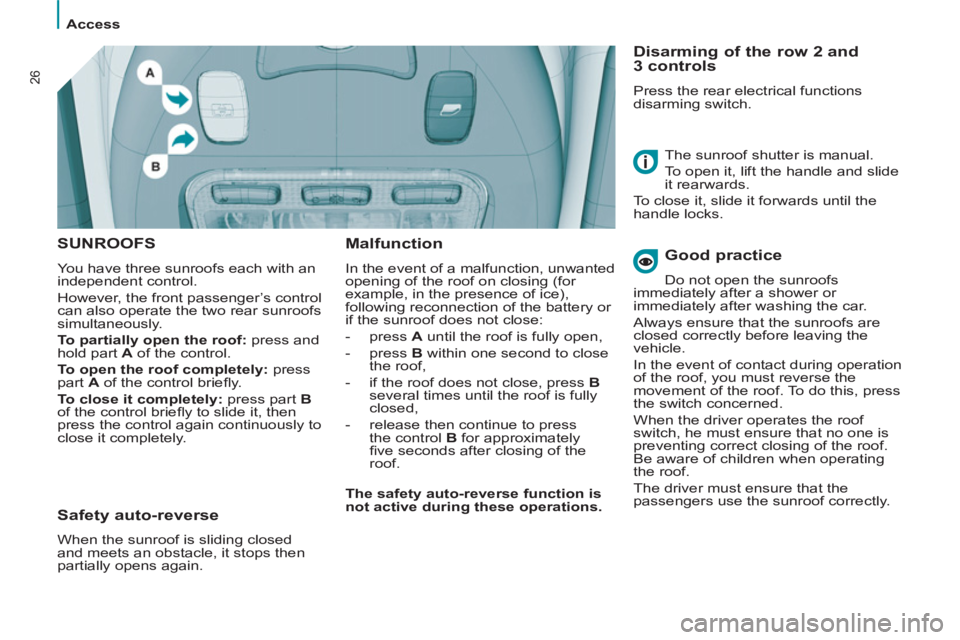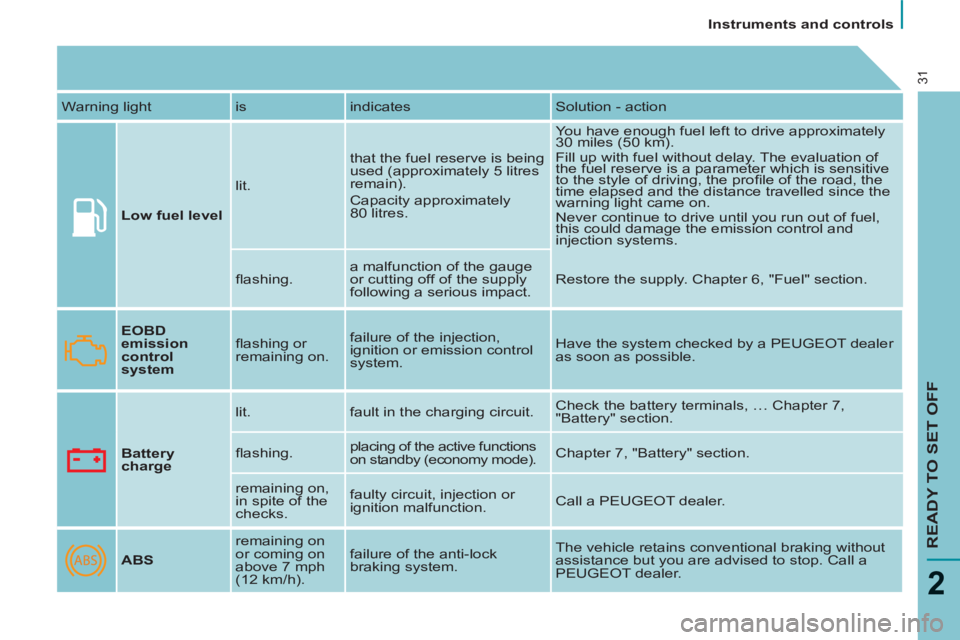2013 Peugeot 807 battery
[x] Cancel search: batteryPage 5 of 234

CONTENT
S
3
Contents
5. ACCESSORIES 103-1077. QUICK HELP 116-131
8. TECHNICAL
D ATA
132-1386. CHECKS 108-11510. VISUAL
SEARCH
139-146
Towing a trailer 103
Roof bars 105
Very cold climate
screen 106
Other accessories 107
Fuel 109
Tank 109
Circuit disarmed 110
Diesel repriming pump 110
Opening the bonnet 111
Diesel under-bonnet
layout 112
Levels 113
Checks 115Battery 116
Changing
a wheel 117
a bulb 121
a fuse 124
a wiper blade 130
Being towed 131
Model codes 132
Diesel 133
Engine 133
Weights and
towing loads 134
Dimensions 136Exterior 139
Interior 140
Front interior 141
Instruments
and controls 142
Technical data -
Maintenance 143
Eco-driving 144
9. TECHNOLOGY on
BOARD
Peugeot Connect
Navigation (RT6) 9.1
Peugeot Connect
Sound 9.61
Peugeot Connect: Peugeot
Connect is the name given
to all of the new equipment
of the radio/navigation
range.
The "Location" section
assists you in fi nding the
controls and functions
and their associated page
numbers on the schematic
outlines of the vehicle
(visual index). The "In-Car Technology"
section presents the new
radio/navigation equipment.
Page 11 of 234

9
1
FAMILIARISATIO
N
Interior
13.
Battery / Fuse box.
14.
Passenger airbag.
15.
Passenger's lower glove box / Fuse
box / RCA sockets.
16.
Air conditioning controls.
17.
Lighter /
12 V accessories socket.
18.
Hazard warning lights switch.
19.
Storage compartment or additional
telematics control.
20.
Cooled compartment.
21.
Ashtray / Can holder.
22.
Seat adjustment control.
23.
Storage compartment.
24.
Handbrake - on the left.
1.
Electric mirror controls.
- Electric window controls.
- Deactivation of the rear electric
controls.
2.
Driver's upper glove box.
3.
Central adjustable vents.
4.
Audio equipment or GPS
multimedia audio equipment with
fl ap.
5.
Instrument panel / Large colour
display.
6.
Sunshine and passenger
compartment temperature sensor.
7.
Passenger's upper glove box.
25.
Bonnet release under cover - on
the left.
26.
Acoustic windscreen.
INTERIOR OVERVIEW
SETTING THE DATE AND
TIME
For more information about
this adjustment, refer to the
"Setting the date and time" section of
the "In-car technology" chapter.
ADDITIONAL HEATER
With the engine at idle
or when the vehicle is
stationary, it is normal
to notice a high-pitched
whistling and a slight emission of
smoke and odour.
Bluetooth.
8.
Windscreen demisting vents.
9.
Speaker (tweeter).
10.
Front window demisting vents.
11 .
Passenger airbag disarming switch,
if fi tted on your vehicle.
12.
Side adjustable vent.
Page 17 of 234

4
244
7
6
4 3 3
415
1
FAMILIARISATIO
N
Interior
Battery
11 6
Child monitoring mirror
102
Disarming the passenger's front airbag
96
Opening control
Sliding side doors from the
inside. 24
Handbrake
86
Bonnet opening controls
The bonnet opening control
is a red handle under a
cover. Release the bonnet
from inside the vehicle then
go to the front and insert
your hand under the badge
to open and raise the bonnet,
place the strut in its location
securely. 111
Safety auto-reverse.
97 102 84 83
Electric windows/Safety auto-reverse
CHILD SAFETY
Monitoring mirror.
Child seats. On a steep gradient,
guide the side door
manually to assist
closing.
closing
Page 22 of 234

Access
20
Changing the remote control
battery
Battery ref.: CR1620/3 volts.
The information "battery fl at" is given
by an audible signal, accompanied by
a message on the multifunction display.
To replace the battery, unclip the
casing using a coin at the ring.
If the remote control does not work
after the battery has been changed,
re-programme the remote control.
Reinitialising the remote control
Following changing of the
remote control battery or
disconnection of the vehicle
battery, the remote control
may have to be reinitialised.
Do not discard the remote control
batteries, they contain metals which
are harmful to the environment.
Take them to a PEUGEOT dealer, or to
any other approved collection point. Wait at least one minute before
using the remote control.
Insert the key in the ignition
switch with the buttons
(padlocks) of the remote
control facing you.
Switch on the ignition.
Press the locking padlock for at least
fi ve seconds within the next ten
seconds.
Switch off the ignition.
Wait at least one minute before using
the remote control.
The remote control is now working
again.
Page 28 of 234

Access
26
SUNROOFS
You have three sunroofs each with an
independent control.
However, the front passenger’s control
can also operate the two rear sunroofs
simultaneously.
To partially open the roof:
press and
hold part A
of the control.
To open the roof completely:
press
part A
of the control briefl y.
To close it completely:
press part B
of the control briefl y to slide it, then
press the control again continuously to
close it completely.
Malfunction
In the event of a malfunction, unwanted
opening of the roof on closing (for
example, in the presence of ice),
following reconnection of the battery or
if the sunroof does not close:
- press A
until the roof is fully open,
- press B
within one second to close
the roof,
- if the roof does not close, press B
several times until the roof is fully
closed,
- release then continue to press
the control B
for approximately
fi ve seconds after closing of the
roof.
The safety auto-reverse function is
not active during these operations.
Disarming of the row 2 and
3 controls
Press the rear electrical functions
disarming switch.
The sunroof shutter is manual.
To open it, lift the handle and slide
it rearwards.
To close it, slide it forwards until the
handle locks.
Good practice
Do not open the sunroofs
immediately after a shower or
immediately after washing the car.
Always ensure that the sunroofs are
closed correctly before leaving the
vehicle.
In the event of contact during operation
of the roof, you must reverse the
movement of the roof. To do this, press
the switch concerned.
When the driver operates the roof
switch, he must ensure that no one is
preventing correct closing of the roof.
Be aware of children when operating
the roof.
The driver must ensure that the
passengers use the sunroof correctly.
Safety auto-reverse
When the sunroof is sliding closed
and meets an obstacle, it stops then
partially opens again.
Page 33 of 234

Instruments and controls
READY TO SET OFF
2
31
Warning light is indicates Solution - action
Low fuel level
lit. that the fuel reserve is being
used (approximately 5 litres
remain).
Capacity approximately
80 litres. You have enough fuel left to drive approximately
30 miles (50 km).
Fill up with fuel without delay. The evaluation of
the fuel reserve is a parameter which is sensitive
to the style of driving, the profi le of the road, the
time elapsed and the distance travelled since the
warning light came on.
Never continue to drive until you run out of fuel,
this could damage the emission control and
injection systems.
fl ashing. a malfunction of the gauge
or cutting off of the supply
following a serious impact. Restore the supply. Chapter 6, "Fuel" section.
EOBD
emission
control
system
fl ashing or
remaining on. failure of the injection,
ignition or emission control
system. Have the system checked by a PEUGEOT dealer
as soon as possible.
Battery
charge
lit. fault in the charging circuit. Check the battery terminals, … Chapter 7,
"Battery" section.
fl ashing. placing of the active functions
on standby (economy mode). Chapter 7, "Battery" section.
remaining on,
in spite of the
checks. faulty circuit, injection or
ignition malfunction. Call a PEUGEOT dealer.
ABS
remaining on
or coming on
above 7 mph
(12 km/h). failure of the anti-lock
braking system. The vehicle retains conventional braking without
assistance but you are advised to stop. Call a
PEUGEOT dealer.
Page 38 of 234

Instruments and controls
36
Zero re-set
Your PEUGEOT dealer carries out this
operation after each service.
However, if you carry out the service
yourself, the re-set procedure is as
follows:
- Switch off the ignition,
- Press and hold the trip recorder re-set
button,
- Switch on the ignition.
The display begins a countdown.
When the display shows "= 0 ", release
the button; the spanner disappears.
Engine oil level indicator
When the ignition is switched on, the
engine oil level is indicated for a few
seconds, after the service information.
Oil level correct
Lack of oil
Flashing of "OIL"
,
linked with the
service warning light,
accompanied by an
audible signal and a message on the
display, indicates a lack of oil which
could damage the engine.
If the lack of oil is confi rmed by a check
using the dipstick, it is essential that
the level is topped up.
Oil level gauge fault
Flashing of "OIL --"
indicates a
malfunction of the
engine oil level
gauge. Consult a PEUGEOT dealer.
Dipstick
A
= maximum, never exceed
this level as a surplus of oil
may damage the engine.
Contact a PEUGEOT dealer
without delay.
B
= minimum, top up the level
via the oil fi ller cap, using
the type of oil suited to your
engine.
Trip recorder zero
reset button
With the ignition on, press
the button until the zeros
appear.
Lighting rheostat
With the lights on, press
the button to vary the
intensity of the lighting
of the instruments and
controls. When the lighting reaches
the minimum (or maximum) setting,
release the button then press it again
to increase (or reduce) the brightness.
As soon as the lighting is of the
required brightness, release the button. The level read will only be correct
if the vehicle is on level ground
and the engine has been off for
more than 15 minutes. After this operation, if you wish to
disconnect the battery, lock the
vehicle and wait for at least fi ve
minutes, otherwise the zero re-set will
not be registered.
Page 41 of 234

Gearboxes and steering wheel
READY TO SET OFF
2
39
- press the lever to the +
sign to change to a higher
gear, from 1 to 6,
- conversely, press the lever
to the - sign to change to a
lower gear. You can change from position D
(automatic mode) to position M
(manual mode) at any time.
Stopping the vehicle, starting
the engine
Reverse gear
- Select position R
, with the
vehicle stationary and the
engine at idle.
If the battery is fl at and the lever is
in position P
, it will be impossible
to change to another position.
- Select position P
to
immobilise the vehicle
or to start the engine
,
with the handbrake on
or off.
- You can also select
position N
to park
or to
start the engine
, with the
handbrake on.
If position N
is engaged
inadvertently while driving, allow
the engine to return to idle before
engaging position D
to accelerate.
Manual mode
Manual changing of the gears by
pressing.
- Select lever position M
, In manual mode, it is only possible to
change from one gear to another if
the vehicle speed and engine speed
permit. If they do not, the vehicle will
operate temporarily in automatic mode.
When the vehicle is stationary or
moving very slowly, the gearbox
automatically selects gear 1.
The �7 (snow) programme does not
operate in manual mode.